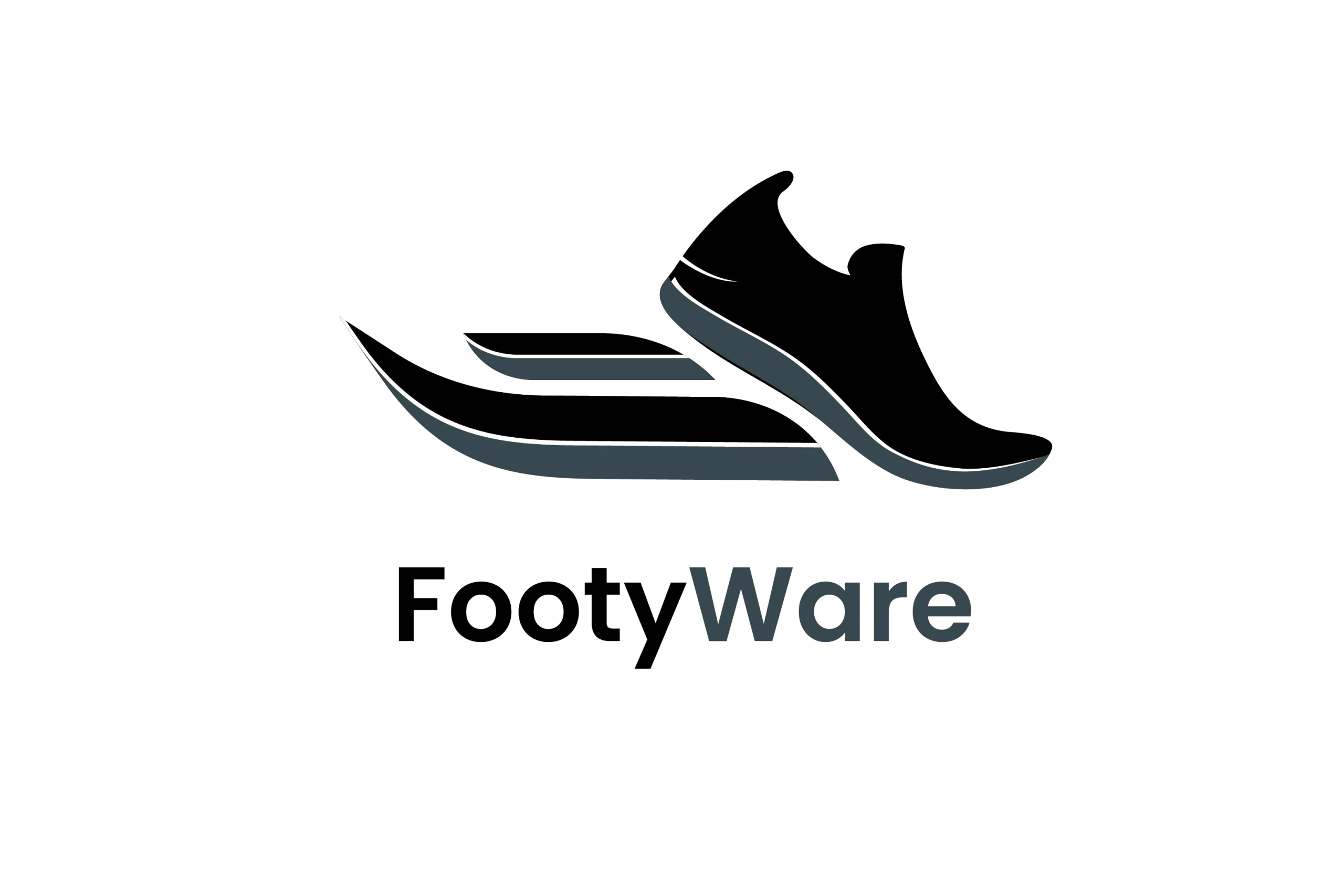Indoor Soccer vs Futsal – Key Differences

At first glance, indoor soccer and futsal may seem like similar variants of the beautiful game, but scratch beneath the surface, and you’ll uncover a world of fascinating differences that shape the unique experiences and skill sets required for each sport.
Let’s kick things off with the playing surfaces:
| Surface | Indoor Soccer | Futsal |
|---|---|---|
| Typical | Turf | Hard court (wood, concrete, etc.) |
| Equipment | Turf shoes with studs | Flat-soled futsal shoes |
While indoor soccer embraces the familiar feel of artificial turf, futsal demands a whole new level of ball control on slick, hard court surfaces, testing a player’s mastery of the first touch.
But the differences don’t stop there. Indoor soccer utilizes a standard soccer ball, while futsal employs a smaller, heavier ball that minimizes excessive bouncing, fostering a game focused on precise passing and close control.
| Key Aspects | Indoor Soccer | Futsal |
|---|---|---|
| Ball Size | Standard | Smaller, heavier |
| Court Size | 82′ x 49′ to 138′ x 82′ | Approx. 200′ x 85′ |
| Team Size | 6 vs. 6 (variations exist) | 5 vs. 5 |
| Game Duration | 2 x 25 minutes | 2 x 20 minutes |
While indoor soccer embraces the familiarity of a full-sized field enclosed by walls, futsal takes place on a compact hard court, intensifying the pace and demanding quick decision-making in tight spaces.
But these distinctions go beyond mere logistics. Indoor soccer, with its turf and walls, encourages a more physical, athletic brand of play, emphasizing endurance and teamwork. Futsal, on the other hand, is a master class in individual skill, ball control, and creative expression, honing the technical abilities that translate seamlessly to the outdoor game.
Whether you’re a seasoned soccer/football expert with an insatiable passion for the game, or a newcomer seeking to develop a deep understanding of soccer tactics and match dynamics from a young age, exploring the nuances between indoor soccer and futsal can unlock new dimensions of your skillset.
So, are you ready to dive into the electrifying worlds of indoor soccer and futsal? Buckle up, because this comprehensive guide will take you on a journey through the key differences, rules, and unique opportunities that each variant offers, helping you decide which one aligns best with your playing style and personal preferences.
General Differences Between Indoor Soccer vs Futsal
| Indoor soccer | Futsal | |
| Playing environment | Only played indoors in a controlled environment | Can be played indoors and outdoors but mostly played indoors |
| Number of players | Depends on the availability of players 4-7 a side with a goalie | 5 a side with a goalie |
| Walls | Walls surround the pitch | No walls |
| Ball | Normal size or any type of football can be used because of its flexibility | The small ball having a low bounce is used |
| Ball circumference | 19.5-25.5 | 27 Inches |
| Surface | Turf courts mostly with side walls. | Flat shining and hard court-like basketball courts |
| Field size | Minimum: 82′ x 49′ Maximum: 138′ x 82′ | 200′ x 85′ (approx.) |
| Time | 2 halves of 25 mins each (Flexible) | 2 halves of 20 mins each |
| Time calculation | Running clock | Stop clock |
| Regulated by FIFA | No | yes |
| Olympic | No | yes |
Advantages of Indoor Soccer
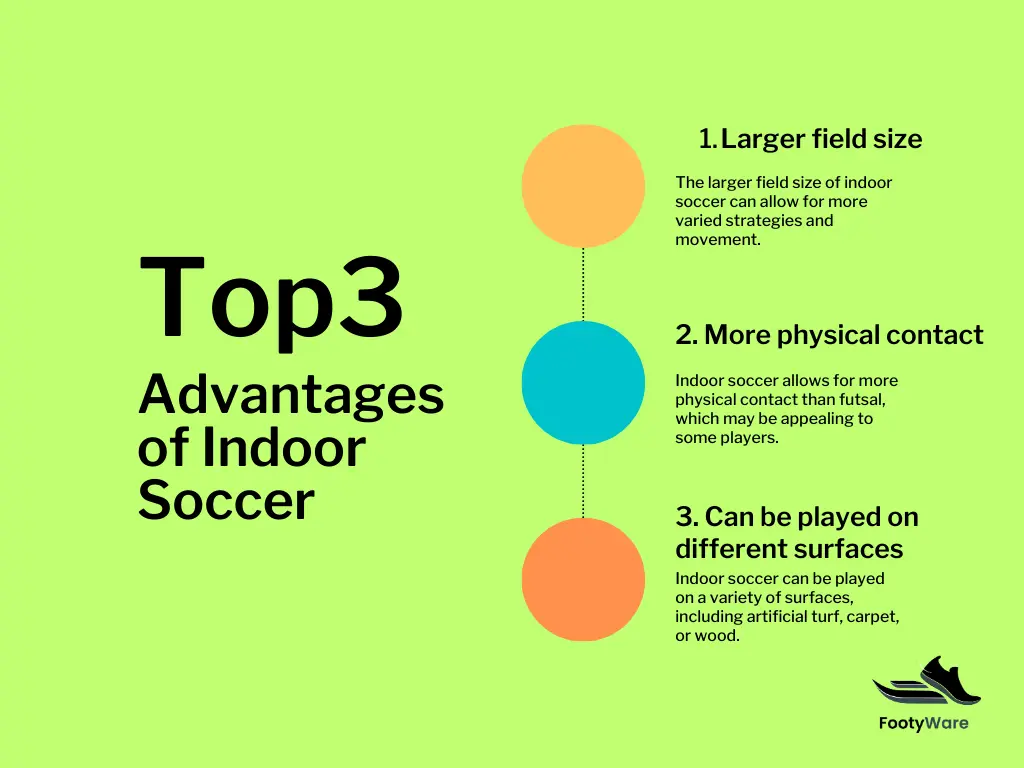
You can play soccer in tight spaces indoors which improves your ball control and you can increase ball control. Ultimately you feel confident on the ball which makes you a more skillful player of the game.
Increasing ball control makes the game fast-paced. You’re able to interact more with your players as compared to normal soccer played on the hard ground because of its size. Indoor soccer is more inclusive and entertaining.
The walls in indoor soccer are used for advantage by the player who has the ball because you are being trapped between defenders you can use the wall as your one-touch partner and skip pass challenges.
Disadvantages of Indoor Soccer
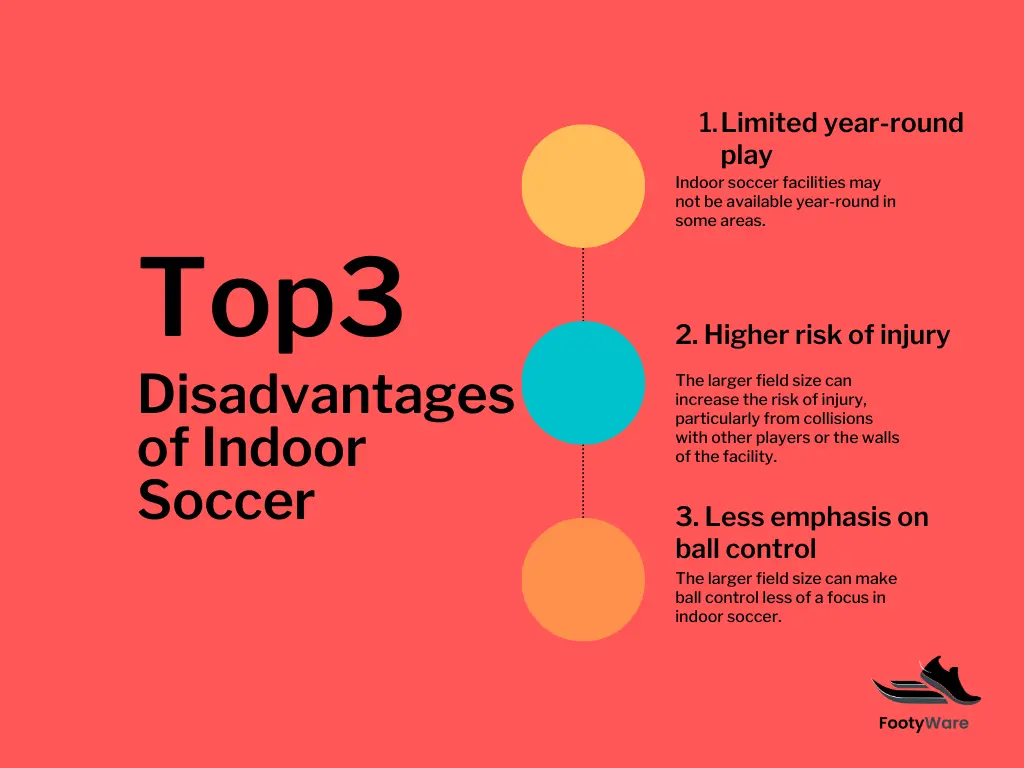
It’s an intense and fast-paced game that often gets physical whenever the game gets competitive and additions of the walls on its side make it more vulnerable to severe injuries.
Indoor soccer is played in tight spaces and on hard ground mostly so the chances of getting injured increase.
The same wall which is an advantage for players having ball possession is a disadvantage for the one who’s defending because the wall makes it difficult for the defender to trap the player. The Wall on the sideline is an awesome one-touch player.
Indoor soccer is not a registered game means it’s not overlooked by FIFA which means that there are no strict rules followed.
Rules must be agreed upon by both teams before the start of the game.
Advantages of Futsal

Futsal is a registered game and FIFA recognizes it. It means tournaments are being held and proper funding is being provided to nations participating in this event or they’re recognized by FIFA.
Playing futsal you can appear on the world map you can easily have names of players in futsal like Falcao and Ricardinho The two giants of the game. Think of the game that wasn’t recognized by FIFA would you have identified them?
It’s all about the recognition and then it’s taken as professional, not like flexible indoor soccer in which you can mold it accordingly but everyone has almost played it whoever is playing soccer. It’s the beginning then you go towards professionalism.
Disadvantages of Futsal
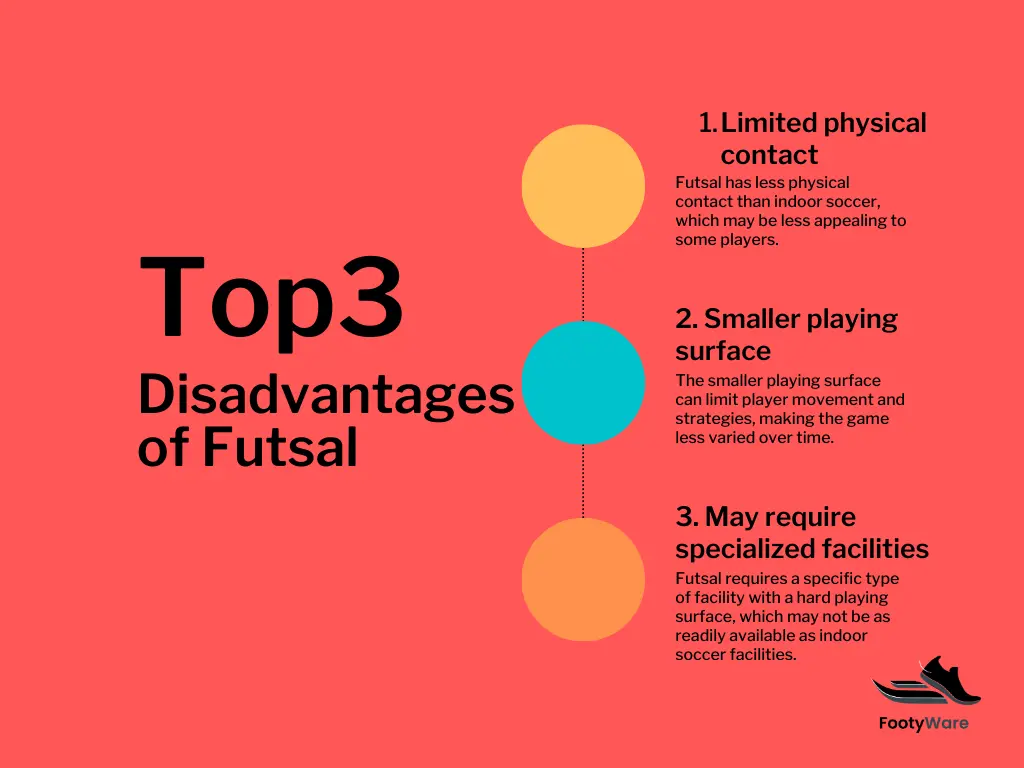
Futsal is played under rules and you can’t shape it according to need because proper rules are being followed. One of them that differs from regular football is that there are no thrown-ins.
It needs a professional attitude and discipline means you’ll have to give proper time to your game. Concentration is the main key if you want to play futsal. Playing under a coach needs a lot of commitment.
You’ve to play as a team and fulfill the duty given by your coach because he is the one who has to execute the playing you’ve to act accordingly.
Beginning of Futsal and Indoor Soccer
Futsal is a 5 side game invented in 1930 in Uruguay. When a Uruguayan soccer diehard fan saw that the courts were empty and nobody was using them he decided why not start small-sided football.
It was a need of the time because soccer was played outdoors on uneven pitches which resulted in severe injuries to minimize this it was a good idea at that time to use empty courts for basketball for futsal.
Indoor soccer is an invention of the United States and Canada because in winter months there was no place to play soccer outdoors because of extreme weather. As basketball is the most played game there, the need for indoor pitches for soccer was evident.
New arenas for indoor soccer were made with walls on their sides so that they may not interrupt other sports. Nowadays indoor soccer is played in winter with the same enthusiasm as in summer due to specialized courts.
Everyone is busy in their lives but they want to remain in touch with soccer somehow. Both have been played by legendary players of soccer like Ronaldinho one of my all-time favorites and then other players like Neymar.
Champions of Futsal (Nations)
Brazil is known as the hub of soccer so you can easily guess who would’ve won more titles being the world champion of futsal. Brazilians are born skillful in the game because of their immense talent.
| Champions of Futsal Nations |
|---|
| 5 times world futsal champions Brazil in 1989, 1992, 1996, 2008 and 2012 |
| 2 times world futsal champions Spain in 2000 and 2004 |
| 1-time world futsal champion Argentina in 2016 |
| 1-time world futsal champion Portugal in 2021 |
Is Futsal Better than Indoor Soccer?
Both are better in their genres it’s your personal choice whatever suits you the most. In the end, it’s soccer the most loved game around the globe.
If you’re a pro then obviously you would love to play a game that’s official like futsal and has a set of rules that are strictly implemented by the referee. Indoor soccer is flexible and can be played according to the needs of the hour.
I would suggest you start with indoor soccer which is flexible and when you feel that you can now give proper time to soccer then start playing under a certified coach with a team that has a proper system and step towards futsal.
Common Things in Indoor Soccer and Futsal
Indoor soccer and futsal both are played on small size pitches with the ball size comparatively smaller than used in normal soccer. The ball preferred by both is of less bounce and easy to control due to the small size pitch. No offside in either.
No throw-in in both with flat outsole shoes with non-marking gum rubber is preferred for flat, hard, and shiny surfaces while for playing on turf you need to have shoes having multiple small rubber studs for the best grip.
Both can be played indoors when the weather outside is freezing or extremely hot. The best choice is to play your favorite sport indoors. Indoor soccer and futsal are played almost with the same formations if the number of players in both are the same.
Difference between Indoor Soccer and Outdoor Soccer
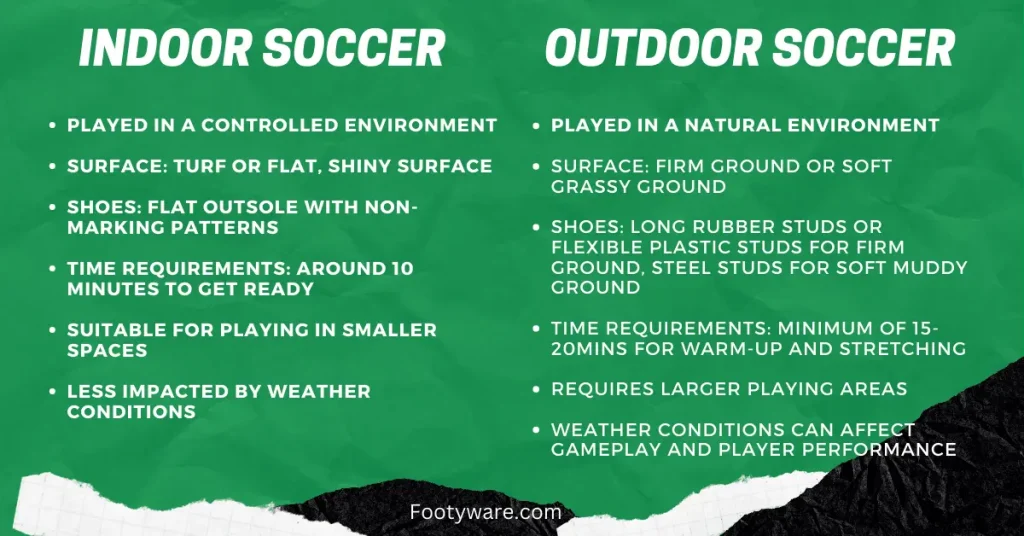
The main difference between indoor soccer and outdoor soccer is that indoor soccer is played in a controlled environment on turf or a flat and shiny surface while outdoor soccer is played in a natural environment on firm ground or soft grassy ground.
Shoes used in indoor soccer have flat outsole of non-marking patterns while outdoor shoes are used having studs of long rubber studs or flexible plastic studs for firm ground and steel studs for the soft muddy ground to have the best traction.
While on turf whether indoors or outdoors you should play in shoes having small rubber studs. I would always suggest using specific shoes for specific surfaces to have the best experience of playing soccer.
Playing soccer outdoors you need at least two hours because you need to do a proper warmup and stretch yourself and it takes normally half an hour if it’s cold while indoors you need 10 minutes to get ready and play for 40-45 minutes.
Best Indoor Soccer and Futsal shoes Recommended
Both indoor soccer and futsal are played on the same surface so if you want to have the top-notch indoor soccer shoes you can have one of these or else read reviews and select the one that you like.
Futsal Rules by FIFA
Rules are for governing the game and keeping it disciplined, as futsal is a registered game that’s governed by FIFA futsal rules. 2 halves of 20 minutes each have to be played with a 15-minute break given in between.
There should be only 4 players and a goalie on the field. The goalie must be different from the other four players playing on the pitch. You’re free to roam around the pitch because the offside rule isn’t applied here.
According to the strategy you can have a minute of timeout per half but you can avail of this if ball possession is with you or the ball isn’t in play. Teams will switch benches after halftime.
Within four seconds goalkeeper must pass the ball to his players and he can’t use his hands before the ball is touched by the opponents. This is done so that players don’t waste time after scoring a goal.
There are unlimited substitutions, but only 5 players on the court in registered futsal tournaments are allowed. No direct goal from a free kick spot as it’s only allowed in outdoor soccer like a historic goal scored by Roberto Carlos.
The Pros and Cons of Indoor Soccer
Pros
Cons
Indoor soccer is not working under the guidance of FIFA so no bothers it but it’s good for beginners to start. It improves ball control because in tight spaces it’s needed. You can shape it according to the availability of players and space.
Walls make it difficult for defenders and they’re unable to judge the direction of the ball because the wall works like a player. It’s usually played casually, especially by beginners used to playing indoor soccer.
The Pros and Cons of Futsal
Pros
Cons
Futsal is being recognized by FIFA and proper funds are being provided to the nations participating in the tournaments that FIFA overlooks. No side walls in futsal but it still needs ball control and dribbling skills.
Time is less to play and some time-wasting tactics are being taught by the coaches that are unethical other than a proper set of rules being followed.
Futsal vs Indoor Soccer Key Differences
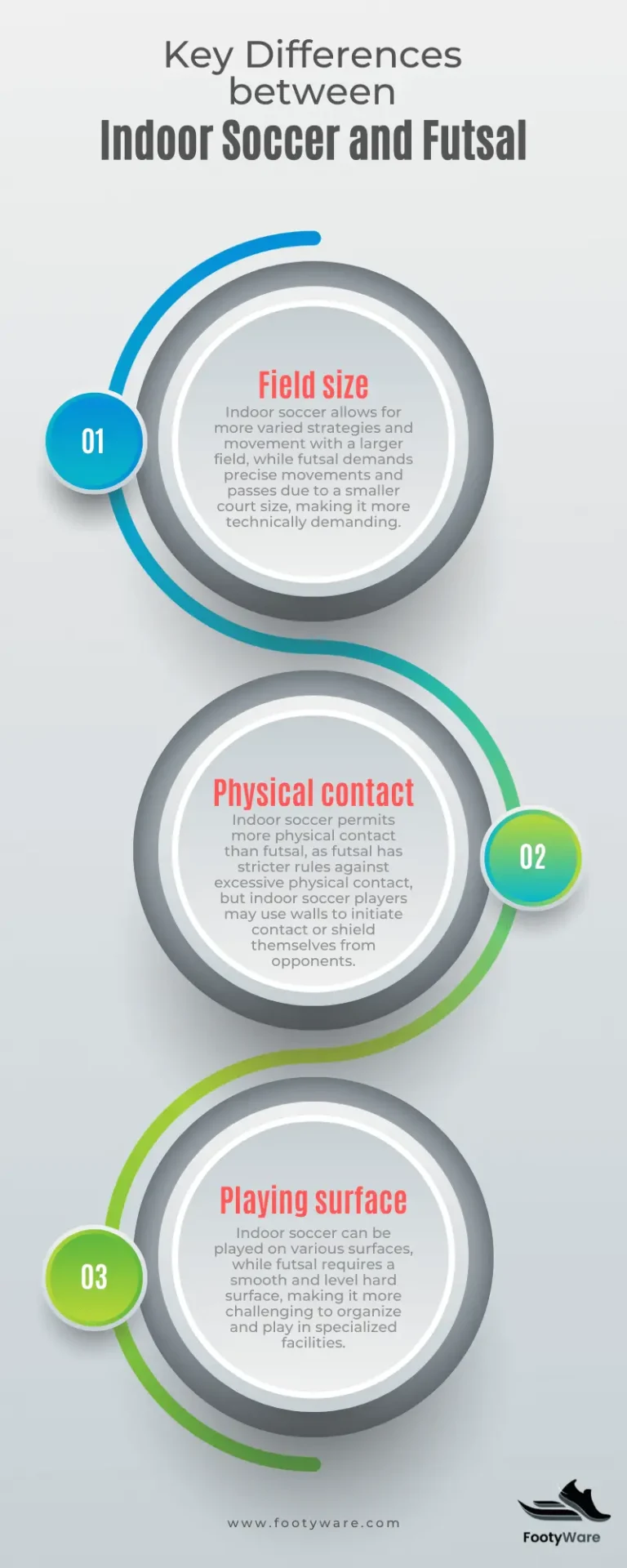
| Indoor Soccer | Futsal |
|---|---|
| Forward, Midfielder, Defender, and Goalie | Pivot, Alas, Fixo, and Goalie |
| 2 halves of 25 minutes | 20 mins halves |
| Throw-ins | Kick in |
| Size 5 ball | Size 4 ball (30% less bounce) |
| Normal ball | Weighted ball |
| Beginner friendly | Not beginner friendly |
Top Futsal Positions for Players
Some of the top futsal positions used globally are the following;
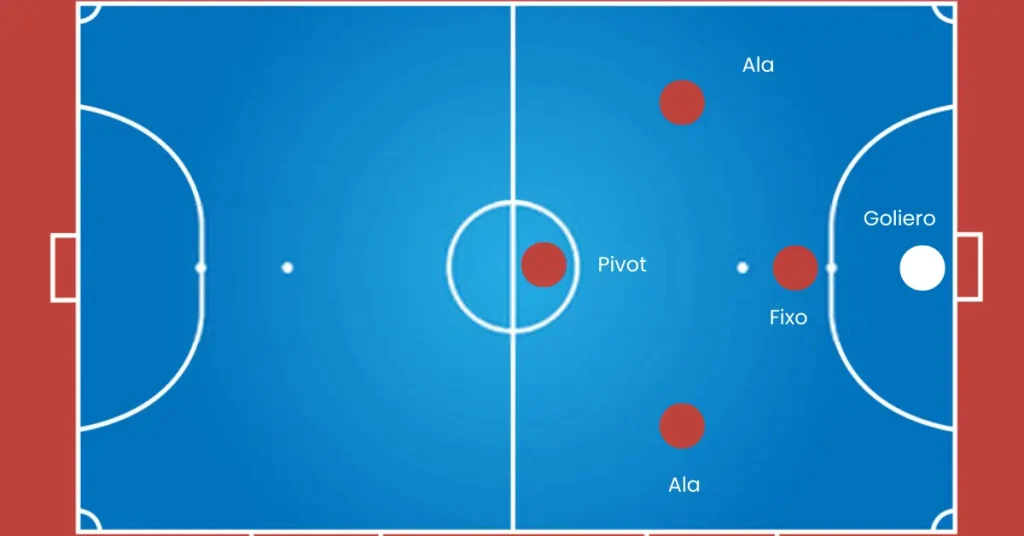
1 Goliero (Goalkeeper)
The goalkeeper must be a brave one with intelligence and the presence of mind is the key. As keepers play at the back one who’s watching the broader picture from the back can guide his team accordingly. It’s the most vital position in a team.
It’s the last wall of defense.
1 Fixo (Defender)
The defender must be very mature calm-minded minded who’s aware of the game. An experienced player at the back should be and should work according to the plan. Defenders must be physically aggressive but mentally cool-minded.
He is the one who has to hold up the play and put in last-ditch tackles to avoid shooting at the goal.
2 Ala (Wingers)
Wingers are the youngest, most skilled, and most talented players in a team who have to run all over the pitch to attack and defend. These are the quickest in making their decisions and moving around.
They should be very responsive in receiving and giving the ball accurately.
1 Pivot (Forward)
You can call him the scorer or striker who is there to put the ball into the net and finish the move. He should be agile and hungry for goals. To keep them coming he has to remain focused and end the game in favor of his team.
These are the widely accepted positions of futsal. They all move around the pitch and make spaces to give and take the ball so that they can keep possession.
Conclusion of Indoor Soccer Vs Futsal
While indoor soccer and futsal share the same roots in the beautiful game, they offer distinct playing experiences that cater to different styles, skill levels, and preferences:
| Aspect | Indoor Soccer | Futsal |
|---|---|---|
| Surface | Turf | Hard court |
| Ball | Standard soccer ball | Smaller, heavier ball |
| Court Size | Larger (82′ x 49′ to 138′ x 82′) | Compact (approx. 200′ x 85′) |
| Team Size | 6 vs. 6 (variations exist) | 5 vs. 5 |
| Game Length | 2 x 25 minutes | 2 x 20 minutes |
| Governing Body | Not regulated by FIFA | Regulated by FIFA worldwide |
💡 Indoor soccer offers:
- A more athletic, teamwork-focused play
- Familiarity with a standard ball and turf surface
- An ideal entry point for beginners
💡 Futsal provides:
- A master class in individual skill and ball control
- Strategic play in tight spaces, testing decision-making
- A structured pathway under FIFA for skill development
Whether you crave the intense physicality of indoor soccer or the technical artistry of futsal, both variants promise:
✨ Opportunities to grow as a player ✨ Unforgettable moments with teammates
✨ Pure excitement in the electrifying world of the beautiful game
So, grab your shoes, step onto the court or turf, and experience the unique thrill that indoor soccer and futsal have to offer!
Indoor soccer
Futsal
I would suggest you start your career with indoor soccer and then go towards futsal. After that, you can start playing soccer outside. Indoor soccer and futsal will improve your skill and ball control. It’s all about the confidence that you need to play the game.
Good luck!!!
FAQs of Indoor Soccer Vs Futsal
Conclusion of Indoor Soccer Vs Futsal
Aspiring soccer stars, rejoice! Indoor soccer and futsal aren’t rivals, but complementary allies in your quest for greatness. Each, backed by prestigious entities like FIFA (futsal) and professional leagues (both), cultivates distinct skills crucial for dominating any battlefield.
Futsal: Imagine a technical crucible – a smaller court, heavier ball, and 5-a-side battle demanding pinpoint control, laser-sharp vision, and lightning passes. This pressure cooker hones your touch, creativity, and decision-making like no other, leading to international tournaments like the Futsal World Cup and even Olympic dreams.
Indoor Soccer: Unleash your inner athletic beast on a full-sized turf. Here, walls, 6-a-side play, and the familiar ball ignite explosive speed, relentless stamina, and tactical awareness. From casual pick-up games to professional leagues, this battlefield builds your physical arsenal to dominate any pitch.
So, which to choose? Both! Serious players know that futsal’s focused technical development complements indoor soccer’s unrestricted movement, crafting a well-rounded maestro.
Practice futsal in tight spaces, then take flight on the expansive indoor pitch. This year-round synergy unlocks your full potential, making you a master of indoor football,
